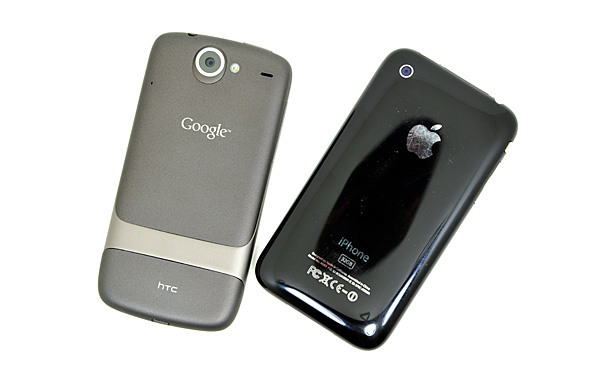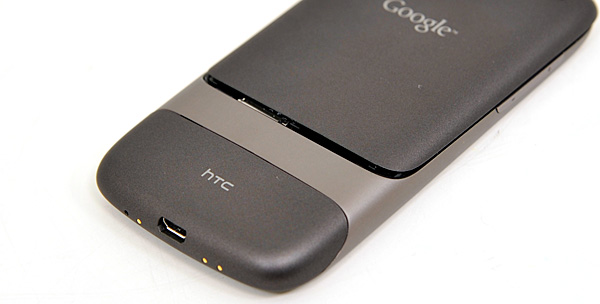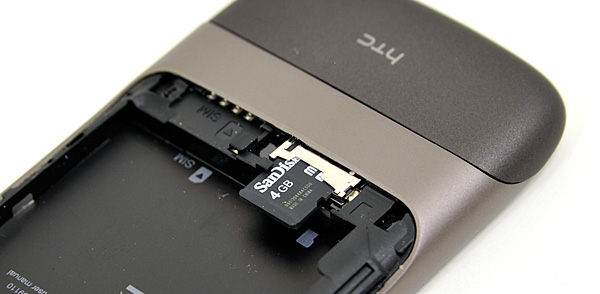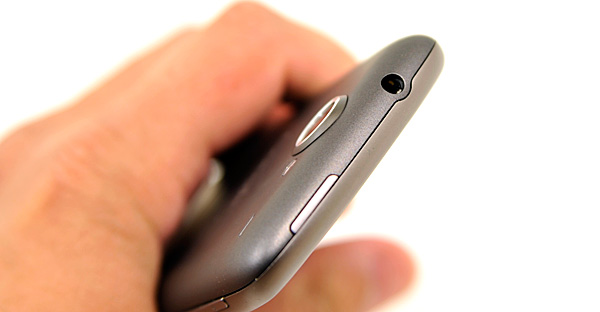Anand's Google Nexus One Review
by Anand Lal Shimpi on April 3, 2010 3:40 AM EST- Posted in
- Smartphones
- Mobile
Experiencing the Nexus, Without Whoopie
Announced in January 2010 and just updated last month to include support for AT&T's network, this is Google's Nexus One manufactured by HTC:

It's got a Qualcomm Snapdragon QSD8250 SoC (more on this later), 512MB LPDDR1, 512MB flash (where apps and the OS are stored), 4GB microSD card (for music/movies/photos) and boasts a 800 x 480 3.7" AMOLED screen.
The design is definitely not as cohesive as the iPhone, but here’s one area where Apple’s ID doesn’t really pay off - for a device that spends most of its life in your pocket, hand or next to your face - styling loses its value pretty quickly. The iPhone looks sleeker, but I’ll take the upgraded functionality of the Nexus One’s camera with flash any day.

The Nexus One is narrower, thinner but longer than the iPhone. The dimensions are as follows:
| Google Nexus One vs. Apple iPhone | |||||
|
Apple iPhone 3GS (ARM Cortex A8)
|
Google Nexus One (Qualcomm Snapdragon QSD8650)
|
||||
| Height | 115 mm (4.5") | 119 mm (4.7") | |||
| Width | 62.1 mm (2.44") | 59.8 mm (2.35") | |||
| Depth | 12.3 mm (0.48") | 11.5 mm (0.45") | |||
| Weight | 133 g (4.7 oz) | 130 g (4.6 oz) | |||
The form factor is both better and worse. Making the Nexus One thinner means that it’s more comfortable to hold up to your head as a phone. You don’t succumb to the iPhone conversation fatigue nearly as quickly. The downside is that the virtual keyboard is narrower, making typing more difficult than the already painful to learn (for some) iPhone keyboard. Personally, I don’t think the tradeoff is worth it. While I believe the Nexus One’s form factor is closer to ideal for carrying around, its keyboard (in portrait mode) is worse off because of it.

This is a normal smartphone after all, so you do get a removable battery. The back cover slides off to reveal a battery, micro SD card slot and SIM card slot. The removable battery is an important addition as you'll soon see. The Nexus One ships with a 4GB micro SD card from the factory.


Charging is done using a micro-B USB cable. Google provides one cable, one power adapter and a set of headphones in the box. The packaging is easily comparable to anything Apple ships. Even the plastic wrap around the cables feels soft to the touch.

You get a standard 1/8” headphone jack up top and to the left of it is your power/lock button. Initial boot on the Nexus One does take a while, I timed it at 48 seconds (that's PC-length!).

As with all other Android phones, you need a SIM and a Google account to make the Nexus One work. Simply typing in your existing Google/Gmail account works, or you can register through the phone’s interface. All syncing with the phone is done over the air and with Google’s servers.
Google doesn’t have a desktop OS (yet), and no thick client desktop apps. Rather than rely on building bridges between its smartphone OS and the desktop applications of its competitors, Google relies entirely on its cloud based services for syncing. Gmail, Google Contacts, Google Calendar, these are your new best friends. Already use all of them? Perfect - your Android phone syncs with your account and you’ll get all of your mail, contacts and calendar events immediately. If you don’t already use them then it’s a lane change. Not a difficult adjustment to make, but transitioning from desktop apps to something entirely cloud based does take some getting used to if you haven’t made the jump prior.










95 Comments
View All Comments
bjacobson - Monday, April 5, 2010 - link
Motorola Droid is no better, my friend has one and OC'd his processor to 1.1Ghz and it still lags just as badly. Both choppy and lags where my finger is. I don't like it at all. This is the main reason I haven't even considered the Android platform yet. I probably will when they fix this.LongTimePCUser - Wednesday, April 14, 2010 - link
Have you tried the Moto Droid after the Android 2.1 upgrade?My experience was that the ui seemed smoother and faster after the upgrade.
eva2000 - Monday, April 5, 2010 - link
bummer about battery life, sounds like nexus rev2 with 1700-1800mah battery in the near future hehhugov - Tuesday, April 6, 2010 - link
I'm not sure the Adreno 200 is as far behind the SGX530/535 as you suggest. The iPhone 3Gs chip (Samsung S5PC100) states in the docs (http://www.samsung.com/global/business/semiconduct... that the GPU is capable of up to 10M triangles/sec, a far cry from the 28M reported in popular press recently. QSD8250 docs suggest up to 22M triangles. And the Adreno is a unified shader architecture GPU with no fixed-function pipes, similar to the PowerVR SGX. OTOH, the *drivers* appear to be quite lacking compared to the PowerVR drivers, at least on Linux/Android.TheHolyLancer - Tuesday, April 6, 2010 - link
I mean wow that dog seems to be focused directly on something above the camera, is that a treat or something?ThePooBurner - Wednesday, April 7, 2010 - link
I really enjoyed reading through this review. I have been wanting to move to a smart phone, but haven't been able to decide what i want. This helps put android devices into perspective in terms of what they can do and what i can expect. I happen to abhor apple, and so i will never own an iphone. I can't stand closed platforms or someone else telling me what i can and can't do with a device that i own. Their stance on "jail-breaking" sickens me. It's like telling me i can't put a new engine in my car if i want to. But that is besides the point. Windows P7 looks like it might be good, but that is a ways off. The Pre-pro looks the most appealing of the phones i have seen reviewed.However, there are 2 devices that i would love to see added to the list of reviewed smart phones: The Nokia n900, and the Samsung Omnia II. For the n900, I would love for you to do a review of it and show us what the Maemo platform can do, as well as a quantifiable battery life test. The phone can do just about everything, but knowing how much doing all of that affects the battery life would be great. The device from a hardware standpoint isn't that different from some of the other smart phones out. It's an Cortex A8 at 600mhz. It's got 32GB of storage (expandable to 48), 5mp camera with flash, WiFi, BT, and it also has an FM transmitter. So on paper it looks great, but there haven't really been any solid reviews on the device from good review sites that use quantifiable testing, or from non-marketing type sites. I know that it also has integration with google voice and google chat. The Omnia 2 has an 800Mhz CPU, and a lot of the same hardware features and uses the TouchWiz 2.0 WM6.5 GUI, which appears to be samsung's platform of choice going forward. It's fairly new so there isn't a whole lot of information out there on this phone yet, but it seems to be marketed as the flagship product from samsung at the moment.
Do you think that you could review these for us? From what i have seen they both look pretty good (though the N900 looks better), but 600$ is a lot to spend without having more than marketing to go off of.
If nothing else this article has at least brought me up to speed on android and it's benefits.
pepsi_max2k - Wednesday, April 7, 2010 - link
"For example, typing yjomh instead of thong won’t autocorrect, although on the iPhone it will. "And I think I speak for everyone, Anand, when I say: Under what situation did you actually find this highly intriguing piece of information out?
SuperFly03 - Thursday, April 8, 2010 - link
Ugh, this review is full of misinformation. I had to say something.http://forum.xcpus.com/blogs/superfly03-341.htm
coolVariable - Thursday, April 8, 2010 - link
1. No mention of the lacking exchange sync.2. No mention of the lacking copy & paste within emails
3. No mention of the connectivity issues.
4. No mention of attachment issues (sending or saving).
5. No mention of file download issues.
...
What a BAD review.
SuperFly03 - Friday, April 9, 2010 - link
I'm not sure what Google phone you are using but the only problem I've had is no. 2. You can't copy paste within emails. I do believe that is a silly limitation but I do not think it is a big problem in the grand scheme of things.No. 1 is complete BS. I have been hooked into my exchange account since day 1 and have never had any issues.
No. 3 is about as generic as you can get. I realize it is a problem that is on the Google sub-forums but likely a firmware issue not an Android issue.
No. 4 and 5 is just laughable.